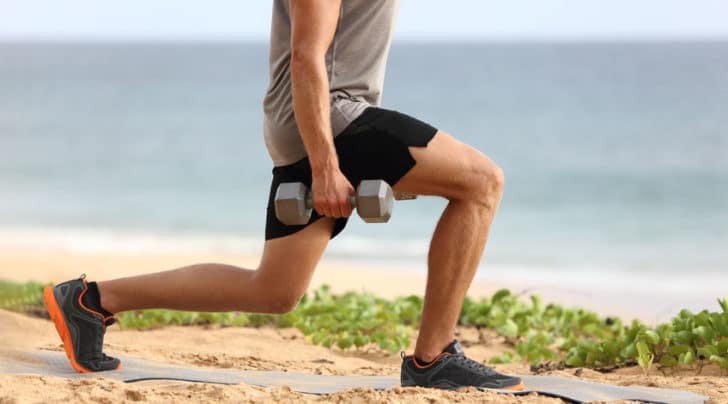
Knee osteoarthritis (OA) is a prevalent cause of pain, lost productivity, and disability. Knee OA hurts. And quite often, it hurts a lot. Osteoarthritis of the knee has been increasing in terms of the percentage of men and women who suffer from it. Thigh weakness has been found in people with knee osteoarthritis. Recent literature appears to suggest that leg strengthening decreases your risk of developing osteoarthritis of the knee. Is thigh strengthening protective for our knee joints? Is this yet another reason why we should start to prioritize leg exercises?
There are many causes of arthritis, and as of today, there are no medications or proven interventions that will prevent arthritis from getting worse. Therefore it is incumbent upon us to initiate appropriate changes to our lifestyle that will minimize our risk of developing osteoarthritis.
In a popular post here on this site, we discussed how our diet and metabolism actually affect our risk of developing osteoarthritis. That post focused on all the changes that take place in our body in response to the foods we eat, our weight, and whether or not we have Diabetes, Metabolic Syndrome, fatty liver and other chronic disease states that are caused by the same metabolic issues that also affect our muscles, joints, and bones.
Your thigh or quadriceps strength appears to be associated with a decreased risk of developing symptomatic osteoarthritis. Leg strength is also critical to aging well. So, simple leg exercises can reduce your risk of developing knee osteoarthritis, and possibly help you live a longer, healthier life. It’s a win-win, and we are going to explore this in more detail.
What is Osteoarthritis?
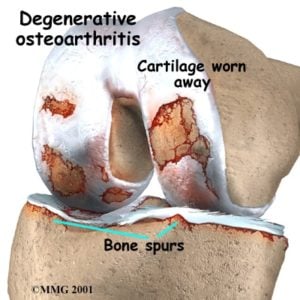
Osteoarthritis, by definition, involves the loss of articular cartilage in the knee. The articular cartilage normally coats the ends of the bones of the knee and serves as a cushion or shock absorber. When the cartilage is healthy, it is thick and robust, and the knee doesn’t hurt or swell. When the cartilage becomes arthritic or damaged, it softens, and it becomes thinner. If the cartilage is softer and more delicate than it is supposed to be, your knee might start hurting you. The arthritic process also causes inflammation. That inflammation leads to fluid (water on the knee), and it is the cause of pain in most cases of osteoarthritis.
Eventually, the cartilage of the knee wears away to the point that the bones of the knee might be touching one another. It is at this point that the pain might be severe enough to warrant consideration of knee replacement surgery. It would seem logical that if we can prove that strengthening the thigh will decrease your risk of progressive, symptomatic osteoarthritis of the knee that you may be interested in starting your quadriceps exercises today!
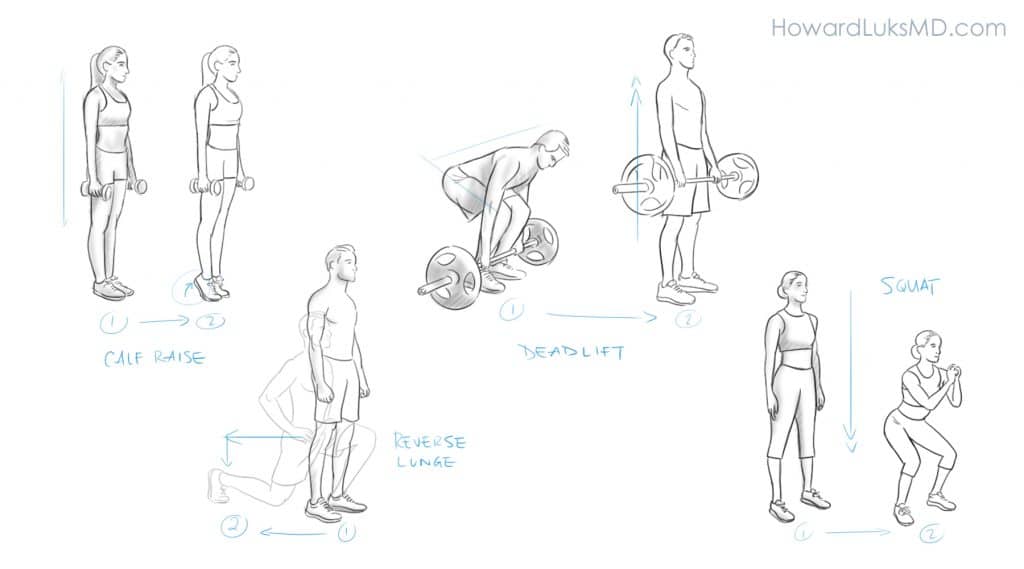
Thigh Strength Is Associated With a Decreased Risk of Symptomatic Osteoarthritis.
Many researchers over the years have performed various experiments to try and prove whether or not thigh weakness led to the development of symptomatic knee osteoarthritis. In women, weakness of the thigh muscles was found to be associated with a higher incidence of painful knee osteoarthritis. This article on our site dove deep into why exercise could make an arthritic knee feel better. The purpose of that post was to quash the thought that OA is a wear and tear process, and it showed how the chemical changes brought on by exercise can improve knee pain.
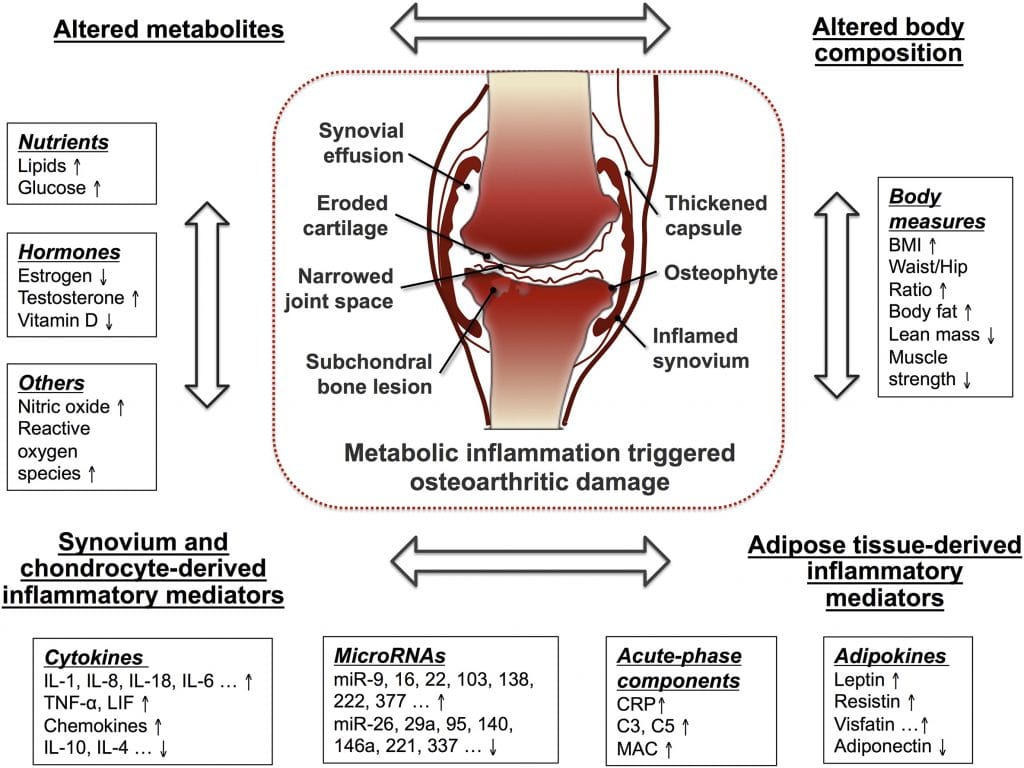
Many scientists believe that thigh muscle strength decreases the risk of developing osteoarthritis of the knee. The precise reasons why exercise might reduce the risk of arthritic progression are still not well understood. Arthritis progression is a very complex topic. As you can see in the image above, there are 100+ chemicals, DNA changes, and hormones that can affect the cartilage, and the pain that you experience.
For example… IL-6 is a well known, highly inflammatory chemical that our body makes. It causes inflammation and pain. It is one of the leading causes of chronic inflammation that leads to a host of diseases in humans, and it is one of the compounds found in the knee that causes pain. IL-6 concentrations go down with exercise, or with running. That’s one of the reasons why a stiff, achy arthritic knee feels better once you get up and get going.
IL-10 is one of your body’s anti-inflammatories. IL-10 concentration will increase with exercise. So exercise can decrease the inflammatory IL-6 while promoting the production of IL-10. This is but one of the 100s of processes that take place in our joints, but it is a clear example of how exercise might improve the environment within the knee and diminish the risk of arthritic progression.
Strengthing improves your stability, balance, and proprioception- known contributors to a decrease in injury rate. Injuries, especially injuries to the cartilage, increases your risk of developing osteoarthritis. Strengthening may decrease certain types of stress placed on the knee with our various activities. Abnormal translational movements are not well tolerated by cartilage in the knee. It induces something we refer to as shear stress. Shear stress can lead to cartilage degeneration and osteoarthritis. The stronger your legs are, the better control you have over the amount of shear stress that your knee is subject to. This may be one of the means by which stronger legs decreases the rate of arthritic progression.
Thigh strength was associated with a decreased risk of arthritis progression after meniscus surgery
Researchers followed a group of their patients for more than ten years. All of these patients had a meniscus tear, which had been operated on. Removing a piece of the meniscus is a known cause of osteoarthritis. After these researchers followed these patients for more than ten years, they obtained follow up X-rays. They found that the patients who had the surgery but maintained strong thigh muscles had less arthritic changes in their knee when compared to those with weaker thigh muscle.
The scientifically inclined among you should be asking whether this is a case of causation or association. We do not know the answer to that yet. In other words, did the stronger legs lead to a decrease in the risk of developing arthritis, or did those patients with less arthritis have stronger legs? Science is challenging. The science of causation is even more challenging. However, the proper take-home messages are that:
- Thigh strength correlates with longevity and fewer chronic diseases: We explored this more in this post.
- Thigh strength improves how an arthritic knee feels. That means that the stronger your legs are the less of a chance that you may require a knee replacement. We explored this in more detail in this post.
- Thigh strength is associated with a decreased risk of developing worsening arthritis after meniscus surgery. Avoiding meniscus surgery is the best way to reduce that risk even further.
- Thigh strength has been shown to correlate with less painful knee arthritis.
Even though it hasn’t been definitively proven to prevent knee arthritis from occurring, it is becoming more and more apparent that an improvement in thigh strength might decrease your risk of developing severe osteoarthritis in need of a knee replacement.
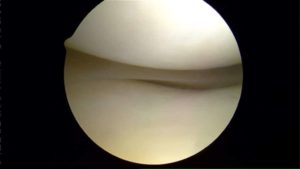
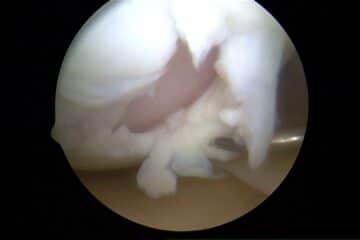


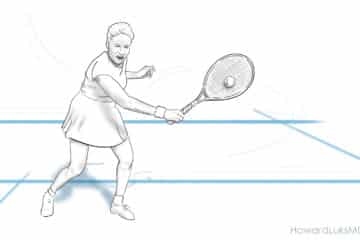
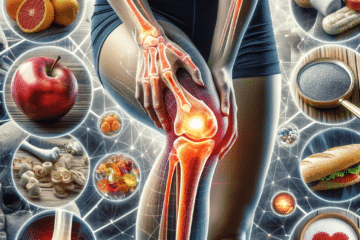
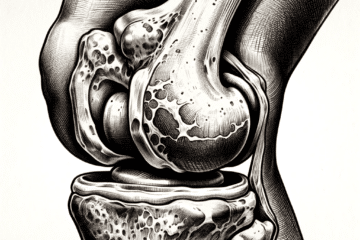
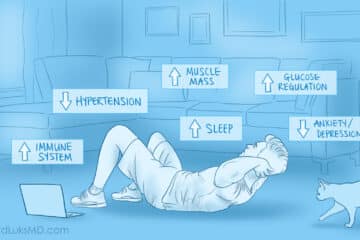




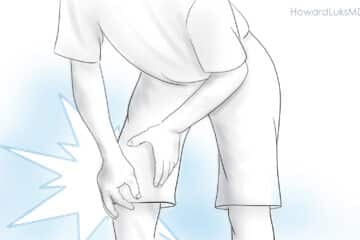
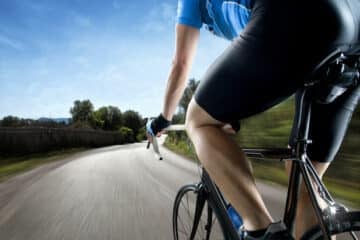

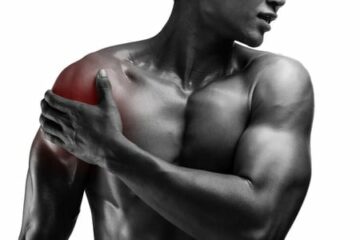
The best information I’ve ever read!
Great! This blog is very helpful and interesting . Thanks for sharing .
That’s very kind! I am very glad that you enjoyed it!